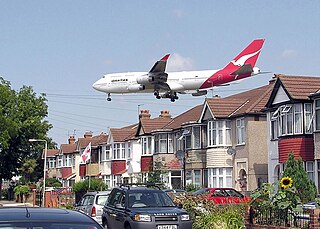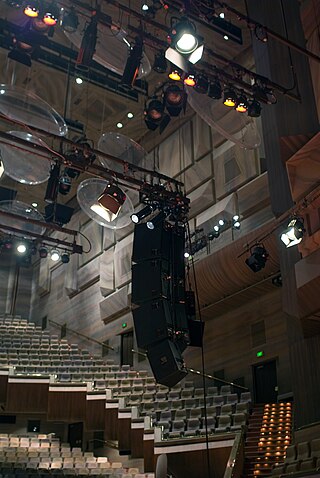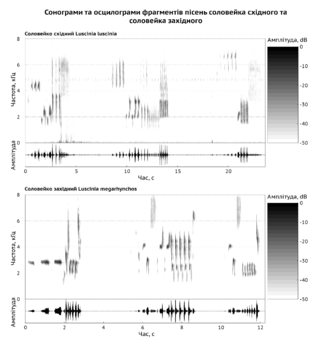Related Research Articles

Acoustics is a branch of physics that deals with the study of mechanical waves in gases, liquids, and solids including topics such as vibration, sound, ultrasound and infrasound. A scientist who works in the field of acoustics is an acoustician while someone working in the field of acoustics technology may be called an acoustical engineer. The application of acoustics is present in almost all aspects of modern society with the most obvious being the audio and noise control industries.

Noise pollution, or sound pollution, is the propagation of noise or sound with ranging impacts on the activity of human or animal life, most of which are harmful to a degree. The source of outdoor noise worldwide is mainly caused by machines, transport and propagation systems. Poor urban planning may give rise to noise disintegration or pollution, side-by-side industrial and residential buildings can result in noise pollution in the residential areas. Some of the main sources of noise in residential areas include loud music, transportation, lawn care maintenance, construction, electrical generators, wind turbines, explosions and people.

Acoustical engineering is the branch of engineering dealing with sound and vibration. It includes the application of acoustics, the science of sound and vibration, in technology. Acoustical engineers are typically concerned with the design, analysis and control of sound.

Bioacoustics is a cross-disciplinary science that combines biology and acoustics. Usually it refers to the investigation of sound production, dispersion and reception in animals. This involves neurophysiological and anatomical basis of sound production and detection, and relation of acoustic signals to the medium they disperse through. The findings provide clues about the evolution of acoustic mechanisms, and from that, the evolution of animals that employ them.
A soundscape is the acoustic environment as perceived by humans, in context. The term was originally coined by Michael Southworth, and popularised by R. Murray Schafer. There is a varied history of the use of soundscape depending on discipline, ranging from urban design to wildlife ecology to computer science. An important distinction is to separate soundscape from the broader acoustic environment. The acoustic environment is the combination of all the acoustic resources, natural and artificial, within a given area as modified by the environment. The International Organization for Standardization (ISO) standardized these definitions in 2014.
Natural sounds are any sounds produced by non-human organisms as well as those generated by natural, non-biological sources within their normal soundscapes. It is a category whose definition is open for discussion. Natural sounds create an acoustic space.
Sound studies is an interdisciplinary field that to date has focused largely on the emergence of the concept of "sound" in Western modernity, with an emphasis on the development of sound reproduction technologies. The field first emerged in venues like the journal Social Studies of Science by scholars working in science and technology studies and communication studies; it has however greatly expanded and now includes a broad array of scholars working in music, anthropology, sound art, deaf studies, architecture, and many other fields besides. Important studies have focused on the idea of a "soundscape", architectural acoustics, nature sounds, the history of aurality in Western philosophy and nineteenth-century Colombia, Islamic approaches to listening, the voice, studies of deafness, loudness, and related topics. A foundational text is Jonathan Sterne's 2003 book "The Audible Past", though the field has retroactively taken as foundational two texts, Jacques Attali's Noise: The Political Economy of Music (1985) and R. Murray Schafer's The Tuning of the World (1977).

Bernard L. Krause is an American musician and soundscape ecologist. In 1968, he founded Wild Sanctuary, an organization dedicated to the recording and archiving of natural soundscapes. Krause is an author, a bio-acoustician, a speaker, and natural sound artist who coined the terms geophony, biophony, and anthropophony.
Hildegard Westerkamp is a Canadian composer, radio artist, teacher and sound ecologist of German origin. She studied flute and piano at the Conservatory of Music in Freiburg, West Germany from 1966 to 1968 and moved to Canada in 1975. She received a Bachelor of Music from the University of British Columbia in 1972 and a Master of Arts from Simon Fraser University in 1988. She taught acoustic communication at Simon Fraser University from 1982 to 1991.
Sensory ecology is a relatively new field focusing on the information organisms obtain about their environment. It includes questions of what information is obtained, how it is obtained, and why the information is useful to the organism.
Biomusic is a form of experimental music which deals with sounds created or performed by non-humans. The definition is also sometimes extended to include sounds made by humans in a directly biological way. For instance, music that is created by the brain waves of the composer can also be called biomusic as can music created by the human body without the use of tools or instruments that are not part of the body.
The following outline is provided as an overview of and topical guide to acoustics:
An autonomous recording unit (ARU) is a self-contained audio recording device that is deployed in marine or terrestrial environments for bioacoustical monitoring. The unit is used in both marine and terrestrial environments to track the behavior of animals and monitor their ecosystems. On a terrestrial level, the ARU can detect noises coming from bird habitats and determine relative emotions that each bird conveys along with the population of the birds and the relative vulnerability of the ecosystem. The ARU can also be used to understand noises made by marine life to see how the animals' communication affects the operation of their ecosystem. When underwater, the ARU can track the sound that human made machines make and see the effect those sounds have on marine life ecosystems. Up to 44 work days can be saved through the utilization of ARU's, along with their ability to discover more species.
The World Soundscape Project (WSP) was an international research project founded by Canadian composer R. Murray Schafer in the late 1960s at Simon Fraser University. The project initiated the modern study of acoustic ecology. Its ultimate goal is "to find solutions for an ecologically balanced soundscape where the relationship between the human community and its sonic environment is in harmony." The practical manifestations of this goal include education about the soundscape and noise pollution, in addition to the recording and cataloguing of international soundscapes with a focus on preservation of soundmarks and dying sounds and sound environments. Publications which emerged from the project include The Book of Noise (1968) and The Tuning of the World (1977), both by Schafer, as well as the Handbook for Acoustic Ecology (1978) by Barry Truax. The project has thus far resulted in two major tours, in Canada and Europe, the results of which comprise the World Soundscape Library. Notable members included John Oswald, Howard Broomfield, Bruce Davis, Peter Huse, Barry Truax and Hildegard Westerkamp.

Soundscape ecology is the study of the acoustic relationships between living organisms, human and other, and their environment, whether the organisms are marine or terrestrial. First appearing in the Handbook for Acoustic Ecology edited by Barry Truax, in 1978, the term has occasionally been used, sometimes interchangeably, with the term acoustic ecology. Soundscape ecologists also study the relationships between the three basic sources of sound that comprise the soundscape: those generated by organisms are referred to as the biophony; those from non-biological natural categories are classified as the geophony, and those produced by humans, the anthropophony.
Ecomusicology is an area of study that explores the relationships between music or sound, and the natural environment. It is a study which encompasses a variety of academic disciplines including musicology, biology, ecology and anthropology. Ecomusicology combines these disciplines to explore how sound is produced by natural environments and, more broadly how cultural values and concerns about nature are expressed through sonic mediums. Ecomusicology explores the ways that music is composed to replicate natural imagery, as well as how sounds produced within the natural environment are used within musical composition. Ecological studies of sounds produced by animals within their habitat are also considered to be part of the field of ecomusicology. In the 21st century, studies within the field the ecomusicology have also become increasingly interested in the sustainability of music production and performance.
Sound maps are digital geographical maps that put emphasis on the sonic representation of a specific location. Sound maps are created by associating landmarks and soundscapes.
A soundwalk is a walk with a focus on listening to the environment. The term was first used by members of the World Soundscape Project under the leadership of composer R. Murray Schafer in Vancouver in the 1970s. Hildegard Westerkamp, from the same group of artists and founder of the World Forum of Acoustic Ecology, defines soundwalking as "... any excursion whose main purpose is listening to the environment. It is exposing our ears to every sound around us no matter where we are."
David Monacchi is an Italian sound artist, researcher and eco-acoustic composer, best known for his multidisciplinary project Fragments of Extinction, patented periphonic device, the Eco-Acoustic Theatre, and award-winning music and sound-art installations.

Christian Lorenzi is Professor of Experimental Psychology at École Normale Supérieure in Paris, France, where he has been Director of the Department of Cognitive Studies and Director of Scientific Studies until. Lorenzi works on auditory perception.
References
- ↑ Wrightson, Kendall. "An Introduction to Acoustic Ecology" (PDF). WFAE. Archived from the original (PDF) on 15 April 2014. Retrieved 14 April 2014.
- 1 2 Paine, Garth (4 May 2017). "Acoustic Ecology 2.0". Contemporary Music Review. 36 (3): 171–181. doi:10.1080/07494467.2017.1395136. ISSN 0749-4467. S2CID 134270318. Archived from the original on 8 March 2022. Retrieved 29 March 2022.
- ↑ "World Forum for Acoustic Ecology". Archived from the original on 11 December 2008. Retrieved 17 December 2008.
- ↑ Cobussen, Marcel (2005). "Towards a "New" Sonic Ecology" (PDF).
- ↑ "phonography.org". Archived from the original on 20 December 2008. Retrieved 17 December 2008.
- 1 2 "World Forum for Acoustic Ecology - Welcome!". World Forum for Acoustic Ecology. Retrieved 10 May 2022.
- ↑ "World Forum for Acoustic Ecology 2006, in Hirosaki, Aomori, Japan". November 2006. Archived from the original on 6 October 2008. Retrieved 17 December 2008.
- 1 2 England, Phil (March 2002). "Sharp Focus on Acoustic Ecology". New Internationalist (343): 33 – via Explora EBSCOhost.
- ↑ Amor, Michelle G. (1 June 2021). "Ecologies of Sound and Sea: An Auditory Journey through Acoustic Ecology". EScholarship.
- 1 2 3 4 Krause, Bernie (2002). "The Loss of Natural Soundscapes". Earth Island Journal. 17 (1): 27–29 – via MAS Ultra - School Edition.
- 1 2 3 Stein, Rachel M.; Rachlow, Janet L. (March 2023). "Acoustic ecology of terrestrial mammals: a new Signaller–Receiver Conceptual Framework". Mammal Review. 53 (3): 143–157. doi:10.1111/mam.12314. S2CID 257546978.
- 1 2 Weiss, Sarah G.; Cholewiak, Danielle; Frasier, Kaitlin E.; Trickey, Jennifer S.; Baumann-Pickering, Simone; Hildebrand, John A.; Van Parijs, Sofie M. (1 August 2021). "Monitoring the acoustic ecology of the shelf break of Georges Bank, Northwestern Atlantic Ocean: New approaches to visualizing complex acoustic data". Marine Policy. 130: 104570. doi: 10.1016/j.marpol.2021.104570 . S2CID 236254741.
- ↑ "Bioacoustics - an overview | ScienceDirect Topics". www.sciencedirect.com. Retrieved 9 May 2022.
- ↑ Shannon, Graeme (17 December 2015). "How noise pollution is changing animal behavior". The Conversation. Retrieved 28 May 2018.
- ↑ Amor, Michelle G. (1 June 2021). "Ecologies of Sound and Sea: An Auditory Journey through Acoustic Ecology". EScholarship.
- ↑ Stefanovic, Ingrid Leman; Scharper, Stephen Bede (2012). The Natural City : Re-envisioning the Built Environment. University of Toronto Press. pp. 163–164. ISBN 9781442698024.
- ↑ Pontificia Universidad Javeriana; Rey Baquero, Maria Paula; Parcerisas, Clea; Seger, Kerri; Perazio, Christina; Botero Acosta, Natalia; Mesa, Felipe; Acosta, Andrea Luna; Botteldooren, Dick; Debusschere, Elisabeth (1 December 2021). "Comparison of Two Soundscapes: An Opportunity to Assess the Dominance of Biophony Versus Anthropophony". Oceanography: 62–65. doi: 10.5670/oceanog.2021.supplement.02-24 .
- ↑ "Soundscape Ecology". Office of International Programs. 29 July 2019. Retrieved 9 May 2022.
- ↑ Lee, John, David Hicks, Danah Henriksen, Punya Mishra, William Cain, Chris Fahnoe, Jon Good, Sarah Keenan, Rohit Mehta, Carmen Richardson, and Colin Terry. "Historical Soundscapes for Creative Synthesis." TechTrends 59, no. 5 (2015): 4–8. Retrieved 2016-08-23.
- ↑ Kang, Jian (2020). "Noise Management: Soundscape Approach1". Encyclopedia of Environmental Health. Elsevier Science & Technology. Retrieved 18 September 2023.
- 1 2 3 Peterson, Ivars (December 1996). "Sounds of the Seasons". Science News. 150 (25/26): 400–401. doi:10.2307/3980071. JSTOR 3980071 – via Explora EBSCOhost.
- ↑ Vuorisalo, Timo; Tucker, Richard; Laakkonen, Simo, eds. (2017). The Long Shadows: A Global Environmental History of the Second World War. Oregon State University Press. p. 191. doi:10.1353/book56054. ISBN 978-0-87071-880-9.
- ↑ Wilford, Dylan Charles; Miksis-Olds, Jennifer L.; Martin, S. Bruce; Howard, Daniel R.; Lowell, Kim; Lyons, Anthony P.; Smith, Michael James (5 August 2021). "Quantitative Soundscape Analysis to Understand Multidimensional Features". Frontiers in Marine Science. 8. doi: 10.3389/fmars.2021.672336 . ISSN 2296-7745.
- ↑ Krause, Bernie (June 1993). "The Niche Hypothesis: A virtual symphony of animal sounds, the origins of musical expression and the health of habitats". The Soundscape Newsletter. 6 (June): 06–10.
- ↑ Dominion , retrieved 9 May 2022
- ↑ Witt, David E.; Primeau, Kristy E. (3 August 2017). "Soundscapes in the past: Adding a new dimension to our archaeological picture of ancient cultures". The Conversation. Retrieved 9 May 2022.



